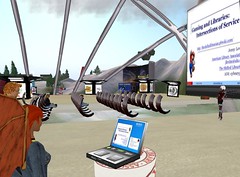How 2.0 R U Now?
Way back in January when we first got started on this blogging journey, many of you took a quiz -- How 2.0 R U? We'd like to see what kind of difference this training has made, so please give the quiz another try and let us know, How 2.0 R U Now?
Some of you followed the training all along, some of you participated every so often, some of you read along silently. We hope everyone found something interesting, something new, and something that will help you help our customers in the future if not now.
Please comment on this final post to let us know what you thought, what you liked, what you didn't, what could be done differently, better, or not at all. This is the feedback we will use to decide where we go next in the 2.0 world.
In the next day or so we'll put the names of those who completed the training in a hat and one lucky blogger will receive an iPod Shuffle. Look for the winner on your library news blog -- LibBlog.
Soon all the participant blogs will be detached from this training blog. If you have a blog it is yours to keep up with, or you can delete it. If you don't plan to use your blog you can go to the same screen you use to create a post, click the Settings tab at the top, scroll all the way to the bottom of the Settings screen and Delete your blog.
This hcplc = lib 2.0 training blog will stay here so you can read and work through the lessons and other posts and continue to learn.
So please, take the quiz, comment on the training, and enjoy the blogosphere!












